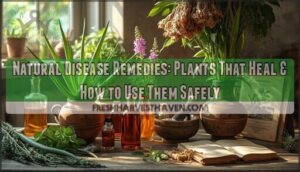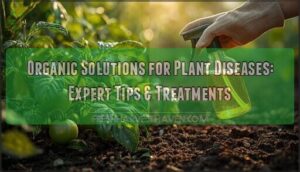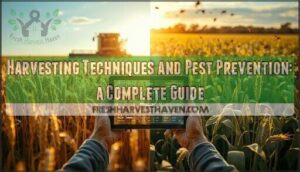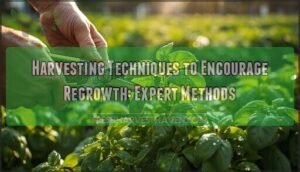This site is supported by our readers. We may earn a commission, at no cost to you, if you purchase through links.

Your grandmother probably kept a windowsill garden of aloe vera and peppermint without thinking twice about it. That quiet tradition connects to something significant: roughly 40% of today’s prescription drugs trace their origins back to compounds first discovered in plants. From willow bark giving us aspirin to foxglove yielding digitalis for heart conditions, natural disease remedies plants have shaped modern medicine in ways most people never realize.
Yet while pharmaceutical companies isolate single compounds, traditional herbalists have long understood that whole plant medicines work differently in your body—often with fewer side effects and broader healing properties. The challenge isn’t whether these remedies work; it’s knowing which plants genuinely help specific conditions, how to use them safely, and when professional medical care matters more than a homemade tea.
Table Of Contents
- Key Takeaways
- Overview of Medicinal Plants for Disease
- Common Herbal Remedies and Their Uses
- Frequently Asked Questions (FAQs)
- How to cure plant disease naturally?
- What are some natural healing plants?
- How do natural remedies impact beneficial insects?
- Are there natural treatments for viral plant diseases?
- What are alternatives to garlic for bacterial control?
- Can natural remedies prevent post-harvest spoilage?
- How to naturally treat soil-borne nematodes?
- How often should natural fungicides be applied?
- Can homemade remedies harm beneficial soil organisms?
- Which natural treatments work best for seedlings?
- Conclusion
Key Takeaways
- Roughly 40% of modern prescription drugs originate from plant compounds, yet whole plant medicines often work with fewer side effects than isolated pharmaceutical versions because multiple compounds interact synergistically in your body.
- Chamomile’s apigenin reduces anxiety symptoms by 53% at 1,500 mg daily, while ginger’s gingerols cut chemotherapy-related nausea by 40%, showing that traditional remedies now have measurable clinical backing.
- Every two plant species lost to extinction eliminates one potential drug discovery, making sustainable harvesting and conservation critical to preserving both current treatments and future medical breakthroughs.
- You’ll need to verify quality sources, watch for interactions with prescription medications, and know when professional medical care matters more than herbal remedies, as even natural compounds carry risks when misused.
Overview of Medicinal Plants for Disease
For thousands of years, people around the world have turned to plants when they needed healing. Today, about 80% of the global population still relies on herbal medicine, and roughly 40% of modern pharmaceuticals come from plant sources.
Understanding how these remedies work—and which plants offer the most promise—can help you make informed choices about your own wellness journey.
Historical and Global Use of Herbal Remedies
Since ancient times, you’ve seen civilizations across the globe trust herbal remedies to heal. Traditional medicine using medicinal plants dates back thousands of years, with Ancient herbalism recorded on Sumerian tablets from 3000 BCE. Today, about 80% of people worldwide still rely on these remedies, showing their deep cultural significance.
Key global traditions include:
- Traditional Chinese Medicine with ginseng
- India’s Ayurveda systems
- Middle Eastern practices from Avicenna
- Indigenous African botanical knowledge
- Japanese Kampo herbal formulations
Modern integration continues through market evolution.
Key Phytochemicals and Their Health Benefits
Plants contain powerful healing compounds called phytochemicals, which are responsible for the pharmacological properties of herbal medicine. Major categories such as carotenoids, plant polyphenols, and isoprenoids provide antioxidant activity, protecting cells from damage. The antioxidant properties of these plant compounds contribute to disease prevention by supporting the immune system and offering antimicrobial effects.
| Phytochemical | Health Benefit |
|---|---|
| Curcumin (turmeric) | Reduces inflammation, fights cancer cells |
| Catechins (green tea) | Protects heart, lowers blood pressure |
| Quercetin (onions) | Antibacterial, reduces swelling |
Quantitative analysis demonstrates that these compounds work synergistically, creating a natural pharmacy right in your kitchen garden.
Popular Medicinal Plants Around The World
These powerful compounds appear in medicinal plants across every continent. You’ll find striking regional plant use patterns shaped by traditional knowledge passed down through generations.
The economic impact is staggering—herbal medicine represents a global market exceeding $230 billion, driven by demand for plant-based products. Consider these widely-used traditional remedies:
- Horehound (Marrubium vulgare) generating over $106 million in U.S. sales
- Ginkgo Biloba (Ginkgo biloba) with 2.4 million American users
- Ginseng (Panax species) expanding from East Asia worldwide
- Yohimbe (Pausinystalia johimbe) from Central Africa earning $67 million domestically
Market growth reflects increasing trust in these time-tested herbal remedies, though plant conservation concerns are rising.
Common Herbal Remedies and Their Uses
You’ve probably heard people talk about chamomile tea for sleep or ginger for an upset stomach, but do these remedies actually work? Many plants have been used for centuries to treat specific health conditions, and some now have scientific research backing up their traditional uses.
Let’s look at several popular herbal remedies, what they’re commonly used for, and what you should know before trying them.
Chamomile for Anxiety and Wound Healing
Chamomile (Matricaria chamomilla) stands as one of our most trusted herbal remedies for calming anxious minds and healing wounded skin. You’ll find relief through its potent flavonoid apigenin, which binds to GABA receptors in your brain. Clinical studies show 1,500 mg daily reduces anxiety symptoms by 53% over eight weeks—far outpacing placebo results.
| Application | Dosage/Concentration | Evidence |
|---|---|---|
| Anxiety relief | 1,500 mg oral extract daily | 53% reduction in anxiety scores vs. 35% placebo |
| Wound healing (topical) | 2.5–10% extract | Significant wound contraction by day 7 |
| Safety profile | Standard therapeutic doses | Mild drowsiness in Every time a plant species disappears, we lose not just greenery but potential cures—with one drug vanishing for every two species lost |
| What Biodiversity Gives You | What Extinction Takes Away |
|---|---|
| 70% of cancer drugs from nature | Access to plant-based natural medicine |
| Unique compound diversity in different regions | Unknown healing compounds forever |
| Traditional uses of herbs passed down | Indigenous healing wisdom |
Sustainable harvesting protects the medicinal properties of herbs you depend on, while preserving herbal medicine benefits for generations ahead.
Future Directions for Sustainable Herbal Remedies
Your path to healing plants starts with protecting them now. Regenerative agriculture and vertical farming offer you sustainable herbal products without depleting wild populations. Here’s what’s shaping plant-based therapy ahead:
- Ethical sourcing ensures fair benefits for communities harvesting medicinal compounds
- Refined quality control uses metabolomics for consistent drug development
- Conservation strategies balance wild collection with cultivated supplies
- Research explores new compounds while preserving biodiversity
These future perspectives in research safeguard your access to nature’s pharmacy.
Frequently Asked Questions (FAQs)
How to cure plant disease naturally?
You can fight plant disease naturally using botanical extracts, biocontrol agents like beneficial bacteria, and cultural controls such as crop rotation. These methods strengthen plant immunity while reducing chemical dependency in your garden.
For example, gardeners can use insecticidal soaps to combat soft-bodied pests.
What are some natural healing plants?
You don’t need exotic species to start—many healing herbs grow right in your backyard. Chamomile, garlic, ginger, and echinacea offer proven medicinal uses through their active compounds and traditional preparation methods worldwide.
These plants have significant medicinal value, as demonstrated by ethnobotanical research in regions like the Kaski District of Western Nepal.
How do natural remedies impact beneficial insects?
Even herbal remedies with medicinal properties can harm pollinators and beneficial predators through botanical pesticide effects.
Integrated pest management demands careful timing and phytochemical interactions awareness to balance plant matter use with pollinator poisoning risks and comparative safety.
Are there natural treatments for viral plant diseases?
You can find gentle protection against viral plant diseases through botanical helpers. Plant-based products with antiviral effects show therapeutic benefits through phytochemical bioavailability, though clinical trial gaps remain and sustainable sourcing matters for medicinal properties.
What are alternatives to garlic for bacterial control?
Ginger, clove, and oregano oils offer antimicrobial action against bacteria. Turmeric’s curcumin and berberine from Berberis species provide herbal antibacterials with proven phytochemical mechanisms.
These traditional alternatives support your immune system and wound healing when used safely.
Can natural remedies prevent post-harvest spoilage?
Nature works like a protective shield here. Plant-based treatments with antimicrobial and antioxidant properties—pomegranate, lemongrass, cinnamon—reduce spoilage considerably.
These phytochemical-rich herbs offer sustainable controls, driving market adoption for residue-free post-harvest solutions.
How to naturally treat soil-borne nematodes?
You can suppress soil nematodes using biofumigant cover crops like mustard or cabbage, which naturally release antimicrobial compounds.
Soil solarization with clear tarps, essential oils, and microbial soil amendments also reduce nematode populations effectively.
How often should natural fungicides be applied?
You should reapply most plant-based fungicides every 7 to 14 days, adjusting for rainfall and disease pressure.
Always follow product labels, monitor crop stages closely, and consider organic practices for sustainable antimicrobial protection.
Can homemade remedies harm beneficial soil organisms?
Yes, homemade herbal remedies can gently disturb the underground ecosystem. Herbal antibiotic residues, heavy metal accumulation, and phytochemical toxicity from concentrated plant extracts affect soil microbial effects and soil biodiversity impact when applied excessively.
Which natural treatments work best for seedlings?
Biofungicides with Bacillus subtilis offer 70–85% protection against seedling diseases, while neem oil nano-emulsion reduces root galls by 64%.
Copper sprays and essential oils like lemongrass also provide effective, natural disease control for young plants.
Conclusion
Picture your kitchen windowsill lined with green allies—chamomile softening anxious edges, ginger quelling nausea, garlic protecting your heart. These natural disease remedies aren’t fairy tales; they’re time-tested tools backed by compounds pharmaceutical companies study.
Yet wisdom lies in balance: respect these botanicals as potent medicine, verify quality sources, watch for interactions with prescriptions, and know when professional care outweighs homegrown remedies. Your grandmother’s instincts were sound—modern science just explained why.
- https://pmc.ncbi.nlm.nih.gov/articles/PMC9984788/
- https://journals.asm.org/doi/10.1128/spectrum.03611-22
- https://extension.missouri.edu/publications/mg13
- https://gardeningsolutions.ifas.ufl.edu/care/pests-and-diseases/pests/management/natural-pest-and-disease-management/
- https://www.nifa.usda.gov/about-nifa/blogs/researchers-helping-protect-crops-pests




